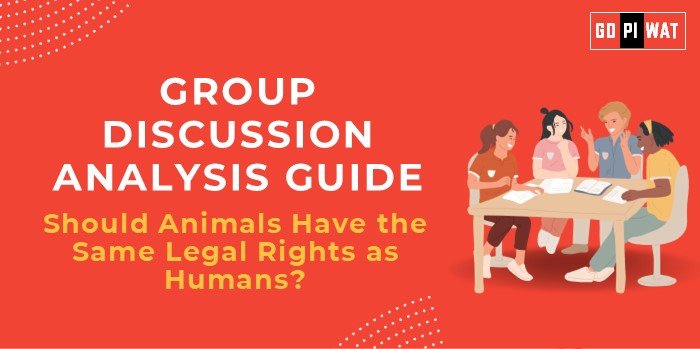📋 Group Discussion Analysis Guide: Should Animals Have the Same Legal Rights as Humans?
🌐 Introduction to the Topic
Opening Context: “As societies progress, ethical considerations increasingly guide policy-making, prompting debates on extending rights traditionally reserved for humans to animals. This debate challenges our understanding of justice and moral responsibility.”
Background: This discourse traces its roots to animal welfare movements and philosophical arguments from thinkers like Peter Singer, who advocate for animals’ intrinsic rights based on their ability to experience pain and suffering. Legal milestones include initiatives such as the inclusion of animal rights in constitutions (e.g., Switzerland) and bans on animal cruelty globally.
📊 Quick Facts and Key Statistics
- 🐄 Global Meat Production: Over 350 million tons annually, raising ethical concerns about factory farming practices.
- 🧪 Animals Used in Experiments: Approximately 192 million animals annually (2023), highlighting the ethical and scientific debates surrounding such practices.
- ⚖️ Legal Protections: 92 countries have enacted specific animal welfare legislation, with varying degrees of enforcement.
- 💰 Economic Value of Wildlife Trade: Over $20 billion annually, underscoring the tension between conservation and exploitation.
👥 Stakeholders and Their Roles
- 🏛️ Governments: Create and enforce animal welfare laws.
- 📣 Animal Rights Organizations: Advocate for stricter laws and educate the public.
- 🏢 Industries: Such as agriculture, pharmaceuticals, and entertainment, often resist regulatory measures.
- 👥 Citizens: Influence policy through consumer choices and activism.
- 🌍 International Bodies: United Nations and World Animal Protection push for global standards.
🏆 Achievements and Challenges
✨ Achievements:
- 📜 Legislative Progress: Countries like the UK and India have established laws prohibiting animal cruelty.
- 🌱 Advances in Alternatives: Growth in plant-based and lab-grown meat industries.
- 📣 Awareness Campaigns: Increased public awareness of animal welfare through social media.
⚠️ Challenges:
- 🌏 Cultural Barriers: Differing views on animals across regions.
- 💼 Economic Resistance: Industries dependent on animal exploitation resist change.
- ⚖️ Enforcement Gaps: Inadequate implementation of existing laws.
🌐 Global Comparisons:
- 🇨🇭 Success: Switzerland integrates animal dignity into its constitution.
- 🌏 Challenges: Countries with weak enforcement, like some in South Asia, struggle to curb exploitation.
📖 Case Studies: India’s ban on cosmetic testing on animals and California’s Proposition 12 mandating larger living spaces for livestock exemplify progressive approaches to animal rights.
💬 Structured Arguments for Discussion
- ✔️ Supporting Stance: “Granting legal rights to animals recognizes their intrinsic value and aligns with moral progress.”
- ❌ Opposing Stance: “Legal rights for animals could severely disrupt industries and cultural practices.”
- ⚖️ Balanced Perspective: “While full legal rights may be impractical, enhanced protections are necessary to reduce suffering.”
🛠️ Effective Discussion Approaches
- 🎯 Opening Approaches:
- 🐾 “Consider the ethical implications of industrial farming, which confines billions of animals annually.”
- ⚖️ “Would legal rights for animals enhance human morality and societal justice?”
- 🔄 Counter-Argument Handling:
- Reference successful transitions in industries (e.g., rise of plant-based alternatives).
- Address cultural concerns with examples of ethical practices that respect traditions.
🔍 Strategic Analysis of Strengths and Weaknesses
- 💪 Strengths:
- Ethical consistency with human rights.
- Potential environmental benefits (e.g., reduced factory farming).
- ⚡ Weaknesses:
- Economic disruptions.
- Enforcement complexities.
- 🌟 Opportunities:
- Growth in cruelty-free industries.
- Enhanced international collaboration on conservation.
- ⚔️ Threats:
- Backlash from industries and communities.
- Risk of uneven implementation.
📚 Connecting with B-School Applications
- 🌍 Real-World Applications: Ethical business practices, sustainable operations, and CSR initiatives.
- ❓ Sample Interview Questions:
- “How can businesses align with stricter animal welfare laws without sacrificing profitability?”
- “Should industries dependent on animal exploitation transition to alternative models?”
- 💡 Insights for Students:
- Focus on ethical leadership and decision-making.
- Explore sustainable supply chains and product innovations.


